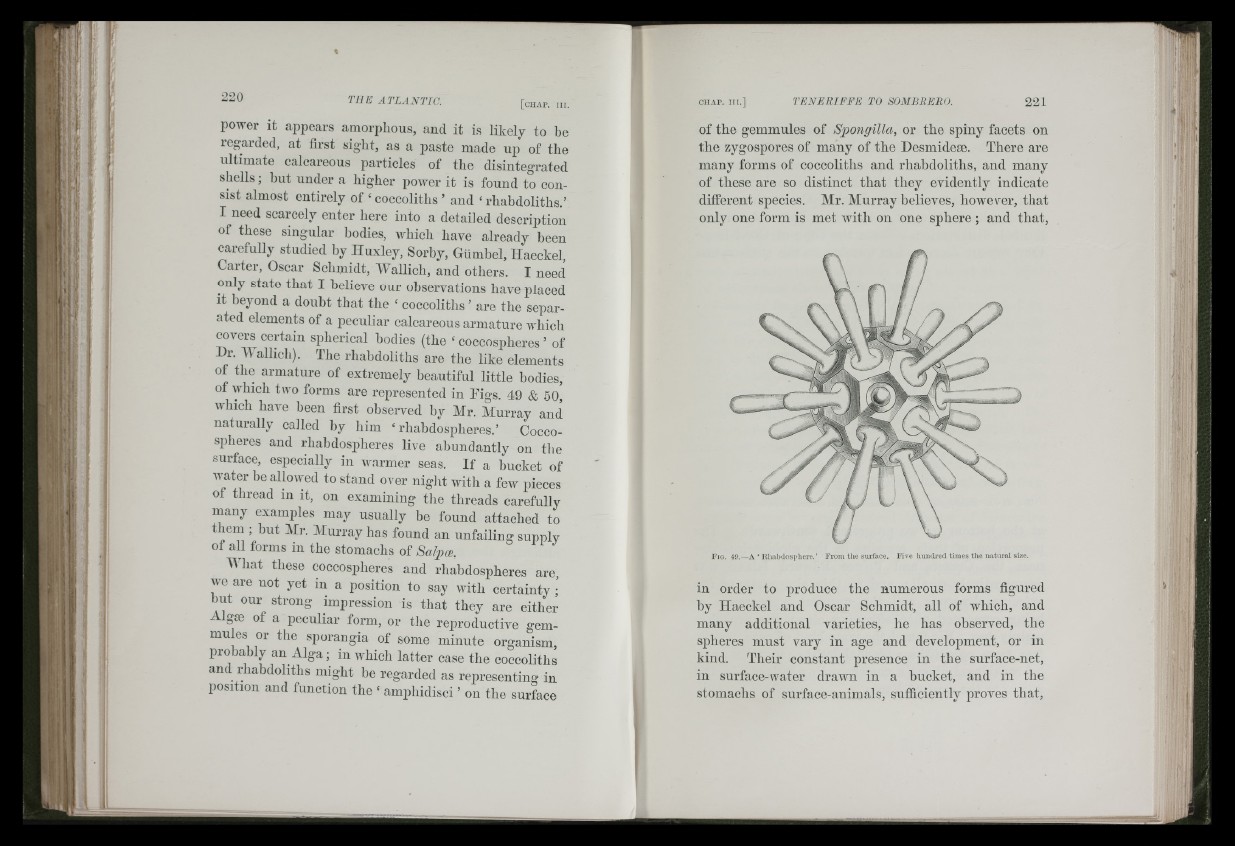
I
nii
1i
t
i■
R J
■, !'J
Mi.
11 ■'
. 1, J
"■ li'te
,'■] j’ r;
P1^3 ri"
III
I'll: I.
I
220 TH E A T L A N T IC . [ c h a p . m .
power it appears amorphous, and it is likely to be
regarded, at first sight, as a paste made up of the
ultimate calcareous particles of the disintegrated
shells; but under a higher pmver it is found to consist
almost entirely of ‘ coccoliths ’ aud ‘ rhahdoliths.’
I need scarcely enter here into a detailed description
of these singular bodies, Avhich have already been
carefully studied by Huxley, Sorby, Gumbel, Haeckel,
Carter, Oscar Schmidt, Wallich, and others. I need
only state that I believe our observations have placed
it beyond a doubt that the ‘ coccoliths ’ are the separated
elements of a peculiar calcareous armature which
covers certain spherical bodies (the ‘ coccospheres ’ of
Hr. IT allieh). The rhahdoliths are the like elements
of the armature of extremely beautiful little bodies,
of which two forms are represented in Eigs. 49 & 50,
Avhich have been first observed by Mr. Murray aud
naturally called by him ‘ rhabdospheres.’ Cocco-
splieres aud rhabdospheres live abundantly on the
surface, especially in warmer seas. I f a bucket of
Avater be alloAA^ed to stand over night with a fcAv pieces
of thread in it, on examining the threads carefully
many examples may usually be found attached to
them ; but Mr. Murray has found an unfailing supply
of all forms in the stomachs of Salpce.
TVhat these coccospheres aud rhabdospheres are,
we are not yet in a position to say with certainty
but our strong impression is that they are either
Algae of a peculiar form, or tlie reproductive gem-
mules or the sporangia of some minute organism,
probably an Alga; in which latter case the coccoliths
and rhahdoliths might he regarded as representing in
position and function the ‘ amphidisci ’ ou the surface
CHAr . I I I .] T E N E R IF F E TO SOMBRERO. 221
of the gemmules of Spongilla, or the spiny facets ou
the zygospores of many of the Hesmideae. There are
many forms of coccoliths aud rhahdoliths, and many
of these are so distinct that they evidently indicate
different species. Mr. Murray believes, however, that
only one form is met Avith ou one sphere; and that,
F ig. 49, —a ‘ Rliabdosphere. ’ From the surface. Five hundi-ed times the n atural size.
in order to produce the numerous forms figured
hy Haeckel aud Oscar Schmidt, all of Avhich, and
many additional varieties, he has observed, the
spheres must vary iu age and development, or in
kind. Their constant presence in the surface-net,
iu surface-water drawn iu a bucket, and in the
stomachs of surface-animals, sufficiently proves that,
■ •'<,1 ■ v!' te
tedll